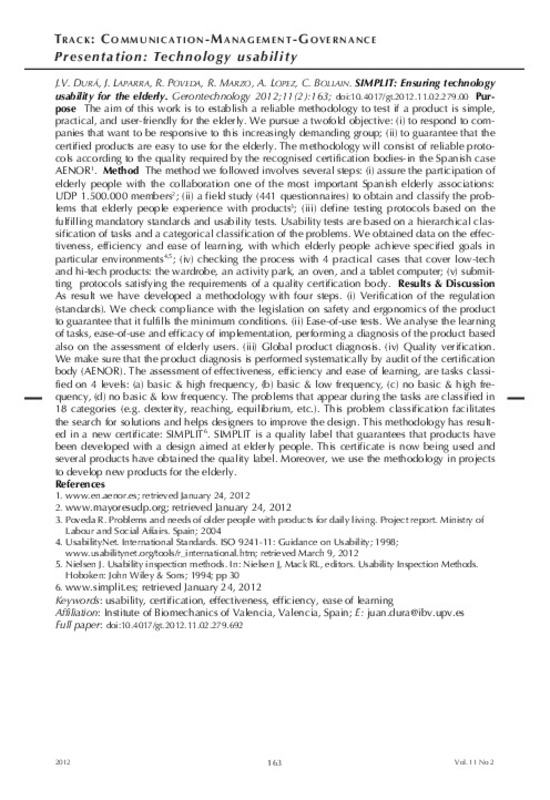JavaScript is disabled for your browser. Some features of this site may not work without it.
Buscar en RiuNet
Listar
Mi cuenta
Estadísticas
Ayuda RiuNet
Admin. UPV
SIMPLIT: Ensuring technology usability for the elderly
Mostrar el registro sencillo del ítem
Ficheros en el ítem
| dc.contributor.author | DURÁ-GIL, JUAN V.
|
es_ES |
| dc.contributor.author | Laparra Hernandez, Jose
|
es_ES |
| dc.contributor.author | Poveda Puente, Rakel
|
es_ES |
| dc.contributor.author | Marzo Rosello, Raquel
|
es_ES |
| dc.contributor.author | López Vicente, Mª Amparo
|
es_ES |
| dc.contributor.author | Bollain Pastor, Clara
|
es_ES |
| dc.date.accessioned | 2016-09-19T06:46:29Z | |
| dc.date.available | 2016-09-19T06:46:29Z | |
| dc.date.issued | 2012 | |
| dc.identifier.issn | 1569-1101 | |
| dc.identifier.uri | http://hdl.handle.net/10251/70039 | |
| dc.description.abstract | Purpose The aim of this work is to establish a reliable methodology to test if a product is simple, practical, and user-friendly for the elderly. We pursue a twofold objective: (i) to respond to companies that want to be responsive to this increasingly demanding group; (ii) to guarantee that the certified products are easy to use for the elderly. The methodol-ogy will consist of reliable protocols according to the quality required by the recognised certification bodies-in the Spanish case AENOR. Method The method we followed involves several steps: (i) assure the participation of elderly people with the collaboration one of the most important Spanish elderly associations: UDP 1.500.000 members; (ii) a field study (441 questionnaires) to obtain and classify the problems that elderly people experience with products; (iii) define testing proto-cols based on the fulfilling mandatory standards and usability tests. Usability tests are based on a hierarchical classifica-tion of tasks and a categorical classification of the problems. We obtained data on the effectiveness, efficiency and ease of learning, with which elderly people achieve specified goals in particular environments; (iv) checking the process with 4 practical cases that cover low-tech and hi-tech products: the wardrobe, an activity park, an oven, and a tablet computer; (v) submitting protocols satisfying the requirements of a quality certification body. Results & Discussion As result we have developed a methodology with four steps. (i) Verification of the regulation (standards). We check compliance with the legislation on safety and ergonomics of the product to guarantee that it fulfills the minimum conditions. (ii) Ease-of-use tests. We analyse the learning of tasks, ease-of-use and efficacy of implementation, performing a diagnosis of the product based also on the assessment of elderly users. (iii) Global product diagnosis. (iv) Quality verification. We make sure that the product diagnosis is performed systematically by audit of the certification body (AENOR). The assessment of effectiveness, efficiency and ease of learning, are tasks classified on 4 levels: (a) basic & high frequency, (b) basic & low frequency, (c) no basic & high frequency, (d) no basic & low frequency. The problems that appear during the tasks are classified in 18 categories (e.g. dexterity, reaching, equilibrium, etc.). This problem classification facilitates the search for solutions and helps designers to improve the design. This methodology has resulted in a new certificate: SIMPLIT. SIMPLIT is a quality label that guarantees that products have been developed with a design aimed at elderly people. This certificate is now being used and several products have obtained the quality label. Moreover, we use the methodol-ogy in projects to develop new products for the elderly. | es_ES |
| dc.language | Inglés | es_ES |
| dc.publisher | International Society for Gerontechnology | es_ES |
| dc.relation.ispartof | Gerontechnology: international journal on the fundamental aspects of technology to serve the ageing society | es_ES |
| dc.rights | Reconocimiento - No comercial - Sin obra derivada (by-nc-nd) | es_ES |
| dc.subject | Usability | es_ES |
| dc.subject | Certification | es_ES |
| dc.subject | Effectiveness | es_ES |
| dc.subject | Efficiency | es_ES |
| dc.subject | Ease of learning | es_ES |
| dc.title | SIMPLIT: Ensuring technology usability for the elderly | es_ES |
| dc.type | Artículo | es_ES |
| dc.identifier.doi | 10.4017/gt.2012.11.02.279.00 | |
| dc.rights.accessRights | Abierto | es_ES |
| dc.contributor.affiliation | Universitat Politècnica de València. Instituto Universitario Mixto de Biomecánica de Valencia - Institut Universitari Mixt de Biomecànica de València | es_ES |
| dc.description.bibliographicCitation | Durá-Gil, JV.; Laparra Hernandez, J.; Poveda Puente, R.; Marzo Rosello, R.; López Vicente, MA.; Bollain Pastor, C. (2012). SIMPLIT: Ensuring technology usability for the elderly. Gerontechnology: international journal on the fundamental aspects of technology to serve the ageing society. 11(2):163-163. doi:10.4017/gt.2012.11.02.279.00 | es_ES |
| dc.description.accrualMethod | S | es_ES |
| dc.relation.publisherversion | http://dx.doi.org/10.4017/gt.2012.11.02.279.00 | es_ES |
| dc.description.upvformatpinicio | 163 | es_ES |
| dc.description.upvformatpfin | 163 | es_ES |
| dc.type.version | info:eu-repo/semantics/publishedVersion | es_ES |
| dc.description.volume | 11 | es_ES |
| dc.description.issue | 2 | es_ES |
| dc.relation.senia | 235667 | es_ES |








